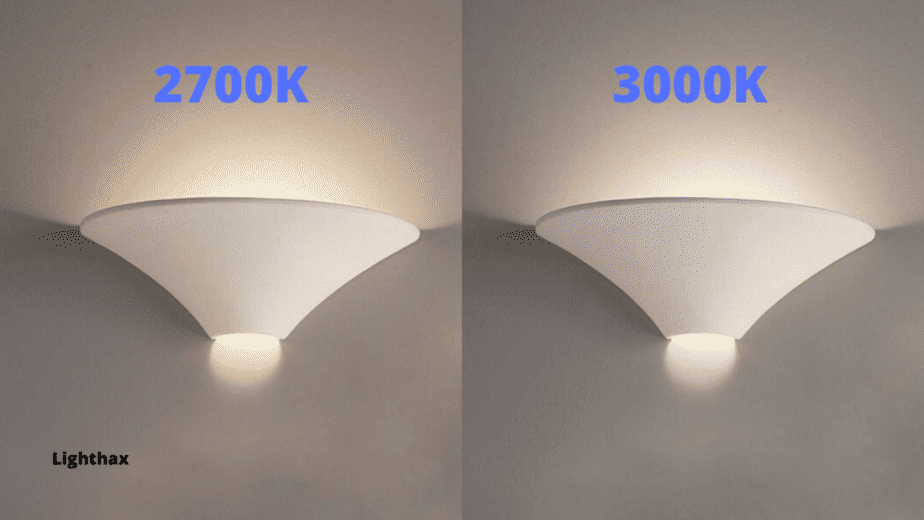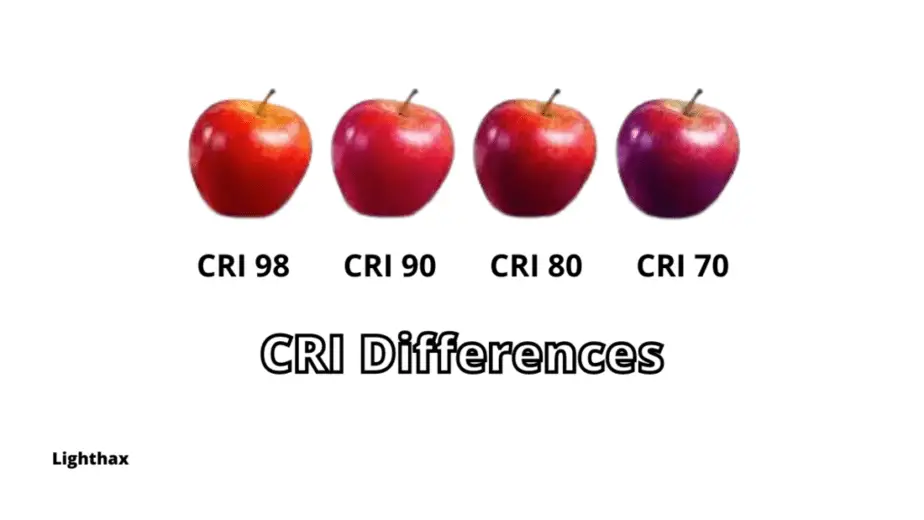So you’re looking for the perfect lighting option for you, whether that be for your home, outdoor or office spaces. You have looked through possible choices out there, and you keep seeing these numbers named 2700K and 3000K describing the light bulbs.
Have you ever wondered what these numbers mean and how do they differ from each other? Well in this article we’ll cover everything there is to know about 2700k vs 3000k light bulbs.
We’ll start off with what these numbers actually mean followed by the difference between these two types of lights. Then we’ll look at the difference of the color temperature between these two.
We’ll talk about how you can use the Color Rendering Index when it comes to making the best choice. Additionally, we’ll discuss which of these lights are best suited for your particular needs.
With all the information coming your way, you can expect to be well versed in all there is to know about 2700k vs 3000k light fixtures.
What Is The Differences Between 2700K and 3000K
In order to differentiate between these two light bulbs, first we need to talk about the Kelvin Scale.
The Kelvin Color Temperature scale is used to describe the way various light temperatures appear visually. The scale ranges from 1,000 Kelvin to 10,000 Kelvin, or 1000k to 10000k.
The lower end of the scale comprises the warmest colors such as orange and yellow. As the scale goes up, the color temperature gets cooler and bluer, thus the higher end of the scale comprises of the bluish white colors.
As the 2700k light is lower on the kelvin scale compared to the 3000k, it can be said that the 2700k has a slightly warmer temperature. This means that compared to the 3000k bulb, the 2700k bulb will have a slightly higher amount of orange-yellowish undertones.

Light Color Temperature: 2700K and 3000K
2700K
The number on the kelvin scale indicates the temperature of the filament of an incandescent light bulb. This means that a 2700k light bulb has the same color temperature of an incandescent (traditional) light bulb when the filament has a temperature of 2700k.
So this means that you can expect a similar color temperature from a 2700k LED light bulb. As we know, incandescent or traditional light bulbs containing filament have their signature yellow-ish color temperature, and a 2700k light bulb is no exception to this.
Various research suggests that lights with warmer temperatures are best suited for calm and cozy environments. The yellow and orange undertones generate hormones in our brain which causes us to have relaxing and soothing emotions.
This means that if you want to create an atmosphere or environment that encourages tranquility and peacefulness, you should definitely consider going for 2700k light bulbs.
3000K
As you should know by now, 3000k sits higher on the kelvin scale compared to 2700k. As the scale moves from warmer colors at the lower end to cooler colors at the higher end, this means that 3000k light bulbs are not as warm compared to 2700k light bulbs.
3000k lights are usually classified as a warm white light temperature. This is because as this temperature sits fairly low on the kelvin scale, it still has warmer tones present.
However compared to a 2700k light bulb, the temperature of a 3000k light bulb is relatively neutral. This is because the 3000k temperature has a lower amount of yellow-orange undertones, which gives it a cleaner, crisper look.
Just like the 2700k light, the 3000k light is also beneficial for a certain kind of environment. As the tones are a little cooler, this temperature is best suited for utility purposes.
Therefore, if you want to set up a professional environment where you want to get tasks and other work done, 3000k would be a more suitable choice.
Use the Color Rendering Index to your advantage
The Color Rendering Index, or CRI, is a very useful tool when it comes to comparing how objects look under natural and artificial light.
Basically, the Color Rendering Index is a measuring method which indicates how much an artificial light can replicate the effect of a natural or standard light source.
A light source’s CRI usually ranges from 0 to 100. This means that the closer the CRI of a light source is to a 100, the better it is at mimicking the effect of a natural light source.
CRI is extremely important when you want the illuminated objects to closely resemble their natural color.

The Optimal CRI
When it comes to choosing the best option for you, CRI may be just as important as 2700k vs 3000k light bulbs. As we said earlier, the higher the CRI the more accurate the light will be at illuminating objects compared to natural light.
For example, you want to go for a more neutral temperature that doesn’t have as much yellow tones. You may think that as the color of the light is more neutral, it’ll do a better job of showing the proper colors of the illuminated area.
You may be wrong.
Even though 3000k lights have a crisper and neutral temperature, if the light itself has a low CRI, it means that the color of the illuminated area will not look natural.
A light with a low CRI can make the illuminated area look unnatural, dull and abnormal. Therefore, make sure to choose a lighting option with a high CRI when buying.
Right Color for Right Place
Based on different scientific studies, it was found that lights of different color temperatures can generate different effects on the human brain. As a result, different temperature lights are appropriate for different purposes.
2700K vs 3000K for Bedroom
As discussed earlier, warmer temperatures of white light are best suited for calm and relaxing environments. This is because lights with warm tones such as yellow and orange generate soothing emotions in the human brain.
As the bedroom is a place where we generally would like to feel relaxed, the 2700k may be the better option.
The 3000k light is more neutral compared to the 2700k light, this means that the 3000k light contains a higher amount of blueish undertones. As the bedroom is a place where we sleep and take rest, it is a good idea to avoid lights with blue hues, as blue light prevents us from falling asleep sooner.
More information about the best color lights for sleeping can be found on this very website.

2700K vs 3000K for Bathroom
When it comes to the correct light temperature for our bathrooms, the approach may be a bit different than that of the bedroom. Bedrooms usually tend to have neutral wall colors, which allows warmer light temperatures to maintain their warmth.
However as bathrooms have tile walls, the color of bathrooms tend to vary. Some bathrooms have neutral colors such as white, beige or other plain colors with light hues. For these kinds of finishes, a 2700k light would be most suitable as the ambience does not need additional lighting.
For bathroom walls that have darker tiles and finishes, a 3000k light would be more suitable. Darker surface colors prevent light from properly scattering and spreading. As a result, the cleaner and brighter temperature of 3000k bulbs would be more appropriate.
One thing should be mentioned here, occasionally bathrooms are used for utility purposes such as putting on makeup. When it comes to makeup, it is essential that the temperature of the light resembles that of a natural outside light.
In this case, going for a light with a higher CRI would be the best option.
2700K vs 3000K for Kitchen
For an area that serves a utility purpose, a neutral light is best suited. Considering 2700k vs 3000k lights, the 3000k light has more neutral tones. This is more appropriate for a kitchen setting.
However, if you want your kitchen to have a relaxing and calming environment, you may also consider the 2700k lighting option.
Just like bathroom spaces, the color of the furniture, cabinetry and appliances in the kitchen also plays an important role in determining the best lighting option.
A kitchen with a completely white cabinet setup may give off a very cold and harsh ambience under a 3000k light. In this case, introducing warmer light temperatures by using a 2700k light bulb would be appropriate.
If you have cabinets and appliances of darker, earthy and natural (wooden) textures and tones, going for a soft daylight 3000k light would be suitable, as the 3000k light would illuminate the contrasting colors very well.
2700K vs 3000K for Living Room
A number of things need to be considered when it comes to choosing the best lighting option for your living room. Firstly, you need to look at the prominent colors in your living room.
You can identify the prominent colors in your living room by looking at the colors of the furniture, walls and other components that are present in the living room.
If the prominent color of your living room is a more neutral color, going for a warmer 2700k light would be the best option. The warmer temperature of a 2700k light would help provide more contrast.
However, if your living rooms contain more natural prominent colors, the cleaner and crisper 3000k light enhance the natural colors.
Additionally, different people use their living rooms for different reasons. People who use their living rooms for relaxing, watching tv and doing other leisurely activities will be better off with using a 2700k light bulb.
However, if you use your living room for official purposes such as conducting and attending meetings, you would be better off using the more neutral 3000k light.

2700K vs 3000K for Outdoor
For outdoor use, if you have a patio or a deck with concrete floors and artificially constructed areas, you may be better off by using the warmer 2700k light.
However, if your outdoor areas have a strong natural presence such as trees and flowers, a 3000k light would really help the color of them come out.
Therefore, it really depends on the atmosphere of the outdoor space.
What Is 2700K Best for?
2700k light fixtures are best for peaceful and calm atmospheres where you want to ideally relax and unwind. Therefore, areas such as bedrooms, patios, tv rooms, living rooms, etc., are best suited for 2700k lights.
Additionally, when it comes to outdoors, living rooms and kitchens, consider the prominent color present in those areas. If the color of the environment is neutral, you may want to use 2700k lights.
What Is 3000K Best for?
The cleaner and crisper 3000k light are best for areas where you need to be productive and maintain a high energy. As a result, areas such as kitchens, home office, study rooms, etc., would be best suited with a 3000k light.
It should be mentioned that if the areas in your house that have darker and natural colors, a light with lower amounts of yellow undertones such as the 3000k light would be better.
FEIT Electric – 3000K A19 LED Light Bulb
A energy saving LED light bulb. 60 watt , 8000 lumens.
Is 2700K or 3000K brighter
Between 2700k and 3000k lights, the 3000k light has more neutral and bluer undertones. In addition, the yellow and orange tones are less present compared to the 2700k light.
As a result, the 3000k light appears to be brighter to the human eye. However in terms of true brightness, you’d have to look at the properties of the exact product you’re purchasing.
Is 2700K warmer than 3000K
As the 2700k light has a higher amount of orange-yellowish undertones as well as a lower amount of blue hue, it has a warmer temperature compared to that of a 3000k light.
Should I use 2700K or 3000K
From all the information presented in the article, it should come as no surprise when we say that when it comes to 2700k vs 3000k lights, at the end of the day it all comes down to your personal choices and preferences.
Scientific data backs the idea that 2700k lights are better for relaxing and 3000k lights are best for productive environments. However, you should also consider the colors present in your surroundings, as the lights should mix well with those colors.
Read also: Can You Sleep with Led Strip Lights On
Ultimately It is Up to You to Choose
No matter what we say and what data we present, you really have to ask yourself what you truly want from the environments you’re lighting.
As the 2700k and the 3000k lights sit pretty closely on the kelvin scale, realistically speaking you will not notice a significant difference between these two.
However, based on the difference that is present we can say that the safer choice for a relaxing and calming environment of a bedroom, bathroom, living room, etc would be best complemented with the use of a 2700k light.
On the other hand, areas with utility purpose such as kitchen, study areas, home office, etc are best suited for the 3000k light.
Read also: 4000K vs 5000K LED Light Color Temperature
FAQs: 2700K vs 3000K
What is better 2700K or 3000K?
The choice between 2700K and 3000K lighting depends on your preference and the intended use. 2700K emits a warmer, more yellowish light, while 3000K is slightly cooler and appears more neutral, making it better for task lighting or spaces where a brighter, whiter light is desired.
Which light color is better 2700K or 3000K?
The preference for 2700K or 3000K light color depends on the specific application and personal preference. 2700K provides a warmer, cozier ambiance often preferred in residential settings, while 3000K offers a slightly cooler and more neutral light, which may be more suitable for task-oriented spaces or modern interiors.
Is 2700 or 3000 Kelvin better for home?
The choice between 2700 Kelvin and 3000 Kelvin lighting for your home primarily depends on your personal preferences and the atmosphere you want to create. 2700 Kelvin is warmer and cozier, often preferred in living spaces and bedrooms, while 3000 Kelvin is slightly cooler and may work well in areas where you need better task lighting, such as kitchens or home offices.
Is 2700 or 3000 Kelvin better for bathrooms?
For bathrooms, 3000 Kelvin lighting is generally a better choice. It provides a brighter and more neutral light that is suitable for grooming tasks like applying makeup or shaving. The cooler temperature enhances visibility and ensures that you get accurate color rendering, which is essential for bathroom activities.
Read also: 3000K vs 4000K – What’s The Actual Difference?
Conclusion: 2700K vs 3000K
In the debate between 2700K vs 3000K lighting, the choice ultimately hinges on the context and atmosphere you wish to create. While 2700K offers a warm and inviting ambiance, ideal for cozy living spaces, 3000K provides a brighter, more neutral light that serves well in task-oriented areas. The key is to carefully consider your specific needs and preferences to select the right Kelvin temperature for your lighting, as both have their distinct advantages.
Read Also: LED Light Colors – What Do They Mean And How Do You Use Them?

My strong expertise is illuminating spaces. With a keen eye for detail and a passion for transforming environments through lighting, my dream is to leave indelible mark on the world of light design. Below are few facts of my biography, highlighting career and hobbies. Click here to contact me.

